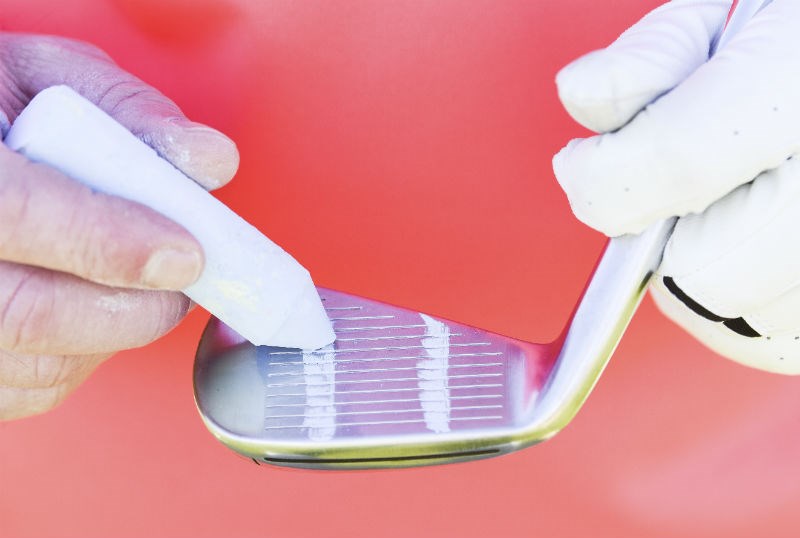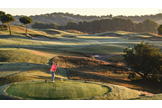Hit More Greens: A 5 Step Guide
Last updated:
A 5-Step Guide To Help You Hit More Greens
Hitting a green in the regulation is deemed so important to your score that there’s even a formula that connects the two. The USGA has determined that if you take your GIR number for a round, double it and subtract the total from 95, you’ll near-as- dammit arrive at your round total. Clearly, the more greens you can hit, the lower your score will be.
That’s why we’ve come up with a five-point plan to help you hit the dance floor more often in 2018, whether that’s from the tee or the fairway… preferably both! Blending technique, simple drills and course management, these tips will have you striking sweeter, straighter and smarter irons this spring. But we’d also urge you to chart your GIR stats throughout 2018. If you want to make progress in this crucial aspect of the game, charting your performance – and improvements – is a key.
Hit More Greens #1: Get your arms and body working together
Great ironplay is about great ball striking, and you can only do that consistently when you can control the basic shape and radius of your swing. Achieving this is all about synchronising the up-and-down action of your arms with the rotation of your body. Known as connection, this is key to creating the consistent arc that promotes reliable contact. Here’s a simple concept that will improve yours.
Lost Arc
In a well-connected swing, body and arms working as one coordinated unit, that gap between your elbows remains pretty constant. Your upper arms stay close to your chest. Problems arise when the gap increases. It reveals the shape of your swing has changed, pulling the club away from its ideal arc.
#1 Elbows: Your Connection is key
Picture yourself at set-up. With your arms relaxed and comfortably extended, feel your elbows are lightly pressed towards each other, as illustrated by the blue bungee I’ve wrapped around mine. Both elbows are also fairly close your sides.
#2 Checkpoint: Splayed at the top
Top-of-the backswing is one of the most common and easily checked positions for separating elbows. It can be caused by your hands and arms moving independently of the body, but poor forearm rotation can also contribute. Either way, your arc and plane are compromised.
#3 Checkpoint: Winning at impact
A second really common sign of loss of connection comes at impact. Ideally, your core will continue to rotate while your hands and arms release the club. But if your chest stalls over the ball, your hands and arms carry on independently. Not only does this create a weak strike; it also forces those elbows to buckle and create a fatal change in the swing’s radius.
The Drill. . .
Better Connection: Maintain The Angle
The key, then, to improving connection is to work on a technique that maintains that elbow gap from start to finish. To help you achieve this, let’s go back to that address position image with the bungee across my elbows. Note how it forms a triangle between my elbows and hands. When your arms and body work together, this triangle broadly retains its shape. So find a bungee or some other stretchable exercise band, position it around your elbows and work through your swing.
Stronger Together
With your elbow band in place, try to cultivate the feeling of your hands and arms moving in harmony with your torso, which releases the club by rotating through impact. As this move begins to feel more natural, you’ll start creating a much more coordinated, powerful and consistent strike
#1: Missing Link
Swing to the top. With your elbows limited to their set-up gap, you are forced into making a more blended and synchronised combination of armswing and body turn. This helps you retain that notional triangle. Note how your trail elbow folds under, staying in front of the turning body.
#2: Strike Gold
Now practise swinging down through impact. You can swing at a ball or just a tee peg; the important thing is to feel how with that consistent elbow gap and triangle shape, your arms and body work together to deliver the club.
#3: Connected to the end
Keep your focus on the triangle right through to your finish; even at this point, your elbow gap should be similar to address. This can only be achieved if your upper body keeps rotating right through to the completion of the swing. Spread elbows at the end is a sign your core is not contributing enough to the blow.
Hit More Greens #2: Heighten your awareness of strike
A sweet-spot strike doesn’t just give you a great feeling – it’s also vital for finding your desired distance and direction. It also avoids so-called “gear effect”, in which toe or heel strikes create spin that causes the ball to curve left or right. Both help accuracy.
◆ A centred strike means optimal energy transfer from club to ball, allowing you to hit the pro distance.
◆ Strike from the middle of the face and it won’t twist open or closed You can improve your strike quality simply by making it your key focus. Here is an exercise that will help you do just that.
Frame The Sweet Spot
Find two pieces of chalk – ideally different colours – and take them to the range. With the first draw two vertical “bars” on the clubface, about an inch apart and either side of the sweet spot.

Mark The Ball
With the second chalk, draw a line on the ball’s equator. When you place the ball on the ground, make sure the mark you’ve made is vertical and facing the square clubface.
Hit The Ball
Take a mid-iron – I’d recommend a 6 or 7 – and address the ball. The two bar markings should help you fix your attention on the clubface and its sweet spot. Check the mark on the ball is facing the clubface, almost against it. Go ahead and hit the shot.
Check Your Mark
After striking the ball, examine the clubface to see where the chalk on the ball left its mark. This will tell you exactly where on the face impact took place. Obviously you’re looking to get this mark dead centre of the two bars. This exercise is not technical, but it forces you to place your awareness on the clubface and your attention on the strike. This is key to finding the sweet spot more often.
Hit More Greens #3: Improve Your Swing Path
To hit greens consistently, you need to be able to swing the club down a consistently neutral path. If you attack the ball excessively from the outside or the inside you will end up having to manipulate the face to avoid big pushes and pulls… an impossible thing to time with any degree of reliability. To improve your path, all you need is two plastic plant marker.
Corridor of Power
Place the plant markers either side of the ball, leaving an inch or each side for the club to pass through. Angle the inner one to match the angle of the shaft. Simply spend time striking balls without hitting either the inner or the outer marker. This forces your swing into that ideal, neutral corridor, allowing you to consolidate both path and face.

Hit More Greens #4: Improve your awareness of the target line
Peg Pointer
From behind the ball it’s quite easy to see your line from the ball to your target area on the green; from beside the ball as you take your stance, it’s much less so. So in practice, as you check your line from behind, place a tee peg in front of the ball, pointing down that line. This won’t just help you aim the blade for your chosen shot shape – it will improve your perception of what ball-to-target looks like when you address the ball.
Feel The Squeeze
The peg also helps with attack angle. The ideal iron strike is slightly descending, almost as if you are trapping the ball between the clubface and turf. This allows the lofted face to compress the ball powerfully. If you can drive the peg forward after the club has struck the ball, you will have shifted the swing’s low point to after the ball… promoting that vital squeezing, downward attack.

Hit More Greens #5: Play smarter from the tee… or fairway
Improving your technique and strike consistency is of course key to hitting more greens – but even the best strike can be undone by a lack of strategy. If you can ask yourself these five questions on every approach shot you play, you will give yourself your best chance of finding the putting surface:
If I miss the green, where can I still up and down it?
When you base your strategy and shot selection on your safest miss, you instantly give yourself more margin for error and take pressure off yourself. In this case the zone is clearly short right of the green. Right-to-left shapers could aim at the right edge of the green and work the ball back to that safe zone; left-to-right players can aim at the pin, shaping the ball towards the right side.
Is the greenkeeper helping me?
Take a look at the mower stripes on the tee. On par 3s it’s so easy to set up square to them, but if you did that on this tee you’d end up aiming straight at that cluster of bunkers left of the green. Never assume mower stripes or even the tee markers themselves are squared up to your line to the green; instead, pick intermediate targets along your target line and use them as your aim reference.
How will the hazard affect my clubbing?
Take a look at this green and you’ll see the two bunkers closest to your ideal target line are short left and long right. This has implications for your club selection, especially in relation to your regular shape. If you move the ball left- to-right, consider taking a stronger club to clear the sand; if you move it right- to-left, a weaker club will leave you short of that rear hazard.

Can I create a better angle for my shaping?
If you’re on a tee, you can improve your chances of success simply by changing the line of your shot. If a left-to-right player hits from the left side of this tee, they’ll bring those left bunkers more into play and it needs less of a slice to find the sand right. From the right, however, they’ll find a clearer line to the pin… and it takes a much bigger slice to find the bunkers right of the green.
Are conditions hurting or helping?
A range of conditions can affect the distance your ball flies. In particular check for:
➤ Time of day: Early rounds can mean colder, heavier air and shorter shots.
➤ Elevation changes: When you’re hitting uphill, the ball spends less time in the air and lands sooner.
➤ Wind: Sounds obvious, but check the flag, clouds and tree tops to form a picture of the wind’s strength and direction.
➤ Ground conditions: Elevated or exposed green complexes will be drier and the ball will tend to release





